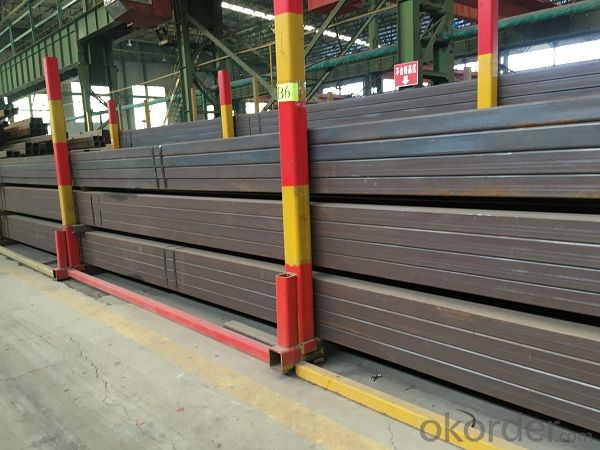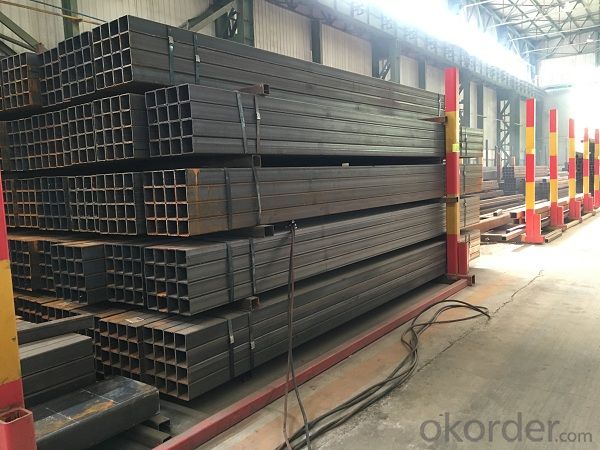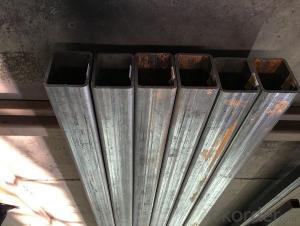National standard low carbon square rectangular tube
- Loading Port:
- Tianjin
- Payment Terms:
- TT OR LC
- Min Order Qty:
- 15 m.t.
- Supply Capability:
- 9800 m.t./month
OKorder Service Pledge
OKorder Financial Service
You Might Also Like
Item specifice
1、Structure of National standard low carbon square rectangular tube:
Square tube, square tube is a kind of call and rectangular tube, is equal and not equal to the length of steel pipe. Is the strip through the process of processing roll system. In general is the strip through the demolition of the package, flat, curly, welded to form a circular tube, and then rolled into a square tube and then cut into a square tube and then cut into the required length.
2、Main Features of National standard low carbon square rectangular tube:
• High manufacturing accuracy
• High strength
• Small inertia resistance
• Strong heat dissipation ability
• Good visual effect
• Reasonable price
3、 National standard low carbon square rectangular tube Specification:
Standard | GB, DIN, ASTM |
Grade | 10#-45#, 16Mn 10#, 20#, 45#, 16Mn |
Thickness | 1.5 - 25 mm |
Section Shape | Square and rectangular |
Outer Diameter | 20*20 mm-------400*400mm 20*30mm*300*500mm |
Place of Origin | Tianjin, China (Mainland) |
Length | 3-12M |
Outer Diameter | 20*20 mm-------400*400mm 20*30mm*300*500mm |
Grade | 235B 345B |
Standard | ASME, ASTM |
1) Material:(ASTM A 106/A53 GRB.API5LGRB,GB,235B,345B
2) Specification range:OD: 20*30mm----300*500mm 20*20 mm---400*400mm ,WT: 1.5 - 25 mm ,length:3-12m or according to the requirement of clients.
3) Excutive standards:GB,ASME API5L.ASTM A 106/A53,Despite of the above
4) Surface:black lacquered,varnish coating or galvanized.
5) Ends:Beveled or square cut ,painted.
6) Packing:bundles wrapped with strong steel strip,seaworthy packing.
4、Packaging & Delivery
Packaging Details: | seaworthy package,bundles wrapped with strong steel strip |
Delivery Detail: | 15-30days after received 30%TT |
5、FAQ of National standard low carbon square rectangular tube:
①How is the quality of your products?
Our products are manufactured strictly according to national and internaional standard, and we take a test
on every pipe before delivered out. If you want see our quality certifications and all kinds of testing report, please just ask us for it.
Guaranteed: If products’ quality don’t accord to discription as we give or the promise before you place order, we promise 100% refund.
②How about price?
Yes, we are factory and be able to give you lowest price below market one, and we have a policy that “ for saving time and absolutely honest business attitude, we quote as lowest as possible for any customer, and discount can be given according to quantity”,if you like bargain and factory price is not low enough as you think, just don’t waste your time.Please trust the quotation we would give you, it is professional one.
③Why should you chose us?
Chose happens because of quality, then price, We can give you both.Additionally, we can also offer professional products inquiry, products knowledge train(for agents), smooth goods delivery, exellent customer solution proposals.Our service formula: good quality+good price+good service=customer’s trust
SGS test is available, customer inspection before shipping is welcome, third party inspection is no problem.
6、 National standard low carbon square rectangular tube Images:


- Q:Can steel pipes be used for HVAC systems?
- Yes, steel pipes can be used for HVAC systems. Steel pipes are commonly used in HVAC systems for their durability, strength, and resistance to corrosion. They are particularly suitable for high-pressure applications and provide reliable and long-lasting performance in HVAC installations.
- Q:What are the advantages of using steel pipes in irrigation systems?
- There are several advantages to using steel pipes in irrigation systems. Firstly, steel pipes are highly durable and resistant to corrosion, providing a longer lifespan compared to other materials. This ensures the longevity and reliability of the irrigation system. Additionally, steel pipes have a high tensile strength, allowing them to withstand high pressure and heavy loads, making them suitable for various irrigation applications. Moreover, steel pipes have a smooth interior surface, minimizing friction and allowing for efficient water flow, which is crucial for irrigation efficiency. Lastly, steel pipes are recyclable, making them an environmentally friendly choice for irrigation systems.
- Q:How are steel pipes used in the manufacturing industry?
- Steel pipes are used in the manufacturing industry for a wide range of applications, including the transportation of fluids and gases, structural support in buildings and infrastructure, and as a material for heat exchangers and boilers. They are also utilized in the production of various machinery and equipment, such as conveyors, cranes, and industrial piping systems. Overall, steel pipes play a crucial role in ensuring efficient and reliable operations across numerous manufacturing processes.
- Q:How do steel pipes handle expansion and contraction?
- Steel pipes handle expansion and contraction through their inherent flexibility and ability to withstand temperature variations. As steel is a ductile material, it can expand and contract without significant deformation or structural damage. Additionally, the use of expansion joints or loops in piping systems allows for controlled movement and accommodates thermal expansion and contraction effectively.
- Q:How do you calculate the pressure drop in a steel pipe?
- To calculate the pressure drop in a steel pipe, you need to consider factors such as the pipe diameter, length, flow rate, and fluid properties. The pressure drop can be determined using various formulas, such as the Darcy-Weisbach equation or the Hazen-Williams equation, depending on the specific conditions and assumptions made. These equations take into account factors like pipe roughness, viscosity, and Reynolds number to determine the pressure drop across the pipe.
- Q:What are the different methods of coating steel pipes for insulation?
- There are several methods of coating steel pipes for insulation, including applying a layer of thermal insulation material, such as foam or fiberglass, directly onto the surface of the pipe, using a heat shrink sleeve or tape to wrap around the pipe, or applying a liquid coating that hardens and provides insulation.
- Q:Can steel pipes be used for conveying gases?
- Yes, steel pipes can be used for conveying gases. Steel pipes are commonly used in various industries, including oil and gas, petrochemical, and construction, for transporting various types of gases such as natural gas, air, and hydrogen. Steel pipes offer several advantages for gas transportation. They are strong and durable, able to withstand high pressure and temperature conditions. Steel pipes also have excellent resistance to corrosion and can effectively prevent gas leakage, ensuring the safety and reliability of the gas transportation system. Additionally, steel pipes have a smooth internal surface, which minimizes the frictional resistance and allows for efficient gas flow. Overall, steel pipes are a reliable and widely-used option for conveying gases in various applications.
- Q:How are steel pipes used in the mining and mineral processing industry?
- Steel pipes are widely used in the mining and mineral processing industry for various applications. They are primarily used for the transportation of water, slurry, and other liquids within the mining operations. These pipes are also used for the conveyance of minerals, ores, and waste materials. Additionally, steel pipes are used in the construction of infrastructure such as mine shafts, pipelines, and underground tunnels in the mining industry. They provide durability, strength, and resistance to corrosion, making them a reliable choice for the demanding conditions of mining and mineral processing.
- Q:Can steel pipes be used for water supply systems?
- Yes, steel pipes can be used for water supply systems. They are commonly used in many industrial and commercial applications due to their durability and strength. However, it is important to note that steel pipes need to be properly coated or lined to prevent corrosion and ensure water quality. Additionally, steel pipes may require more maintenance compared to other materials like PVC or copper.
- Q:Why should the weak electricity be pre buried with galvanized steel pipe?
- Galvanized steel pipe mainly because of anti-interference and electrical connectivity, to prevent other strong magnetic strong signal to interfere with weak signal, while in the electrical connection, galvanized steel pipe can be directly connected to the bridge.
1. Manufacturer Overview |
|
|---|---|
| Location | |
| Year Established | |
| Annual Output Value | |
| Main Markets | |
| Company Certifications | |
2. Manufacturer Certificates |
|
|---|---|
| a) Certification Name | |
| Range | |
| Reference | |
| Validity Period | |
3. Manufacturer Capability |
|
|---|---|
| a)Trade Capacity | |
| Nearest Port | |
| Export Percentage | |
| No.of Employees in Trade Department | |
| Language Spoken: | |
| b)Factory Information | |
| Factory Size: | |
| No. of Production Lines | |
| Contract Manufacturing | |
| Product Price Range | |
Send your message to us
National standard low carbon square rectangular tube
- Loading Port:
- Tianjin
- Payment Terms:
- TT OR LC
- Min Order Qty:
- 15 m.t.
- Supply Capability:
- 9800 m.t./month
OKorder Service Pledge
OKorder Financial Service
Similar products
New products
Hot products
Related keywords






























